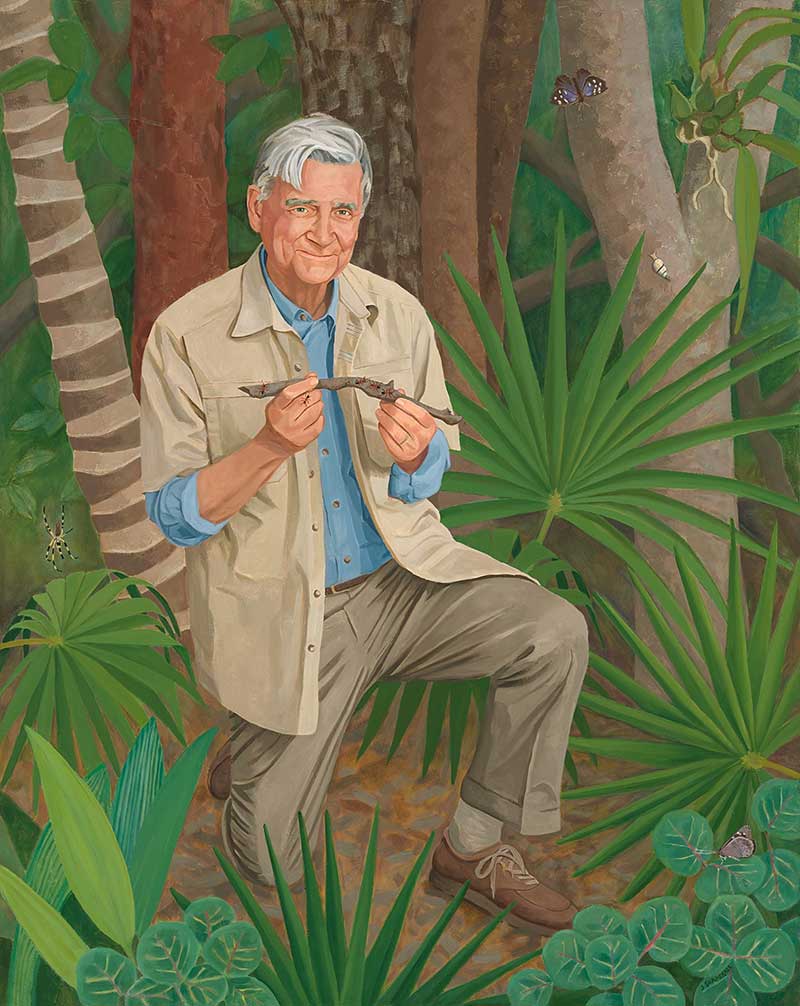E. O. Wilson (born 1929)

About the Sitter
Biologist Edward O. Wilson—two-time winner of the Pulitzer Prize—has been a leader of the biodiversity movement and a passionate advocate for environmentalism for the past half-century. Growing up in Alabama, Florida, and Washington, D.C., he became fascinated with the natural world at a young age. When a fishing accident blinded him in one eye, he narrowed his focus to insects, beginning a survey of the ants of Alabama.
Trained as an entomologist specializing in myrmecology (the study of ants) at the University of Alabama and at Harvard, Wilson has ranged from New Guinea and Sri Lanka to the Smithsonian Institution for his work. He joined the faculty of Harvard University in 1956 and is currently the Pellegrino University Professor Emeritus and Honorary Curator in Entomology there. A hallmark of his later work has been an attempt to bridge the gap between science and the culture at large, as in Consilience: The Unity of Life (1998). In 2005 he was involved in the founding of the E. O. Wilson Biodiversity Foundation. The recipient of numerous awards and honors, including the National Medal of Science, Wilson published his first work of fiction, Anthill, in 2010, at the age of eighty.
Artist Jennie Summerall posed Wilson in a setting reminiscent of the landscape on Lignumvitae Key in Florida, an unspoiled ecosystem that he helped preserve from development in the 1960s. According to Summerall, while “other painters have depicted E. O. Wilson in his academic mode, … I decided after reading his wonderful autobiography, Naturalist, to set him in nature. He liked the idea, so I combined photos I took of him in Cambridge with images I collected on a trip to Lignumvitae Key in Florida.” The painting references Wilson’s earlier studies on ant populations, while depicting him as he looks today.
For more information on Wilson and his work, see:
The E.O. Wilson Biodiversity Foundation
http://www.eowilson.org/
NOVA: Lord of the Ants (PBS)
http://www.pbs.org/wgbh/nova/eowilson/
Learning to Look
- Describe the setting and objects in this portrait. Where is Wilson? What do you see around him? What is he holding? Why might the artist have chosen to portray Wilson in this setting?
- If you did not know anything about E. O. Wilson, what could you learn about his life and work from the way that he is portrayed in this painting?
- Focus on the ant crawling on Wilson’s finger. Why do you think the artist included that detail? How does it affect the portrait as a whole?
- Artist Jennie Summerall has said that she hopes this painting “conveys a sense of [Wilson’s] obvious love for his life in the field, and for the miraculous biodiversity of the world which he worked so hard to decipher and preserve, as well as his kind and open nature.” What elements in the painting reflect her hopes for it? In what ways (if any) do you think she has succeeded in these goals?
Activity: The Uses of Contemporary Portraiture
In addition to being displayed prominently in the NPG exhibition “Twentieth-Century Americans,” this portrait of E. O. Wilson has been used to illustrate websites and a television documentary about his life and work. Contemporary portraits serve many different purposes—artists create them to celebrate a sitter’s achievements, to illustrate articles, to advertise, and for many other reasons.
Encourage students to explore the uses of contemporary portraiture by having them bring in examples of portraits from newspapers, posters, websites, and other sources. Have students compare and contrast their examples, asking why these portraits were created and what they reflect about the sitters